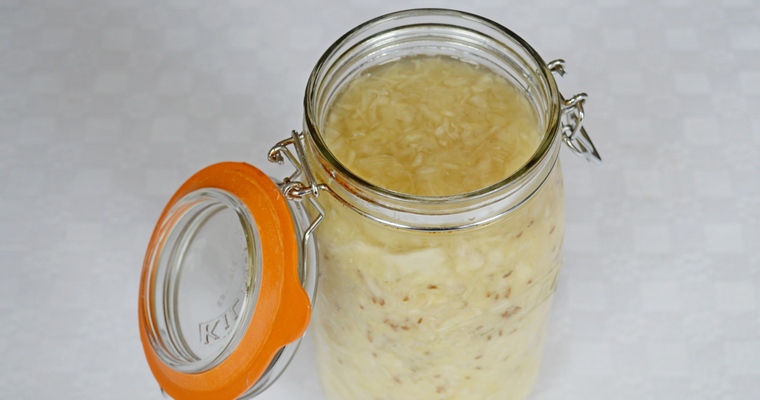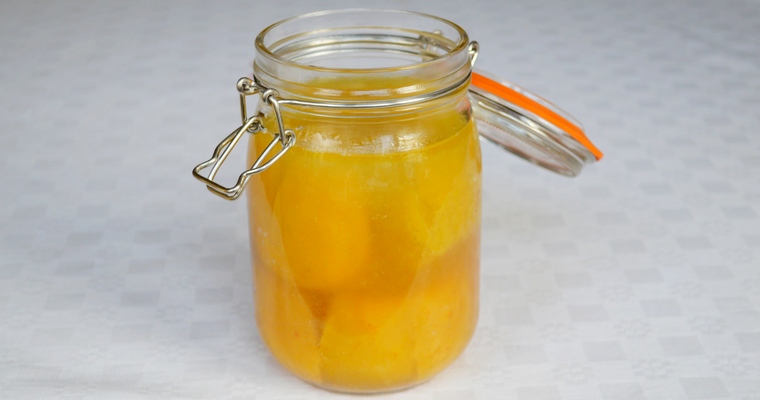Recipe for making a classic eastern European condiment for pork sausages. Fermenting cabbage to make your own tangy and sour sauerkraut is quick and easy.
| Skip straight to the recipe |
01. What is sauerkraut?
Sauerkraut is a condiment made from shredded white cabbage leaves that have been pickled in a brine of their own juices and salt, and then left to age for at least 1 week, but usually for several months. The preserving process changes the flavour and develops an intriguingly tangy sourness. When ready to use, the cabbage is drained and served in small quantities. Sauerkraut is commonly found in central and eastern Europe – usually served alongside fatty meats like pork sausages, as a means to cutting through the richness. It is an example of lacto-fermenation.
02. What is fermentation?
Fermentation is a method of preserving food using bacteria. Whilst most methods of food preservation aim to remove bacteria altogether, or at least slow the rate at which they can reproduce, fermentation actively encourages bacterial growth. Not all bacteria cause food to spoil. In fact, some bacteria are not just harmless but beneficial, in that they create an acidic environment that discourages ‘bad’ bacteria from growing. The acidity of a substance is measured on a scale of 1 – 14 called the pH scale, with 1 being very acidic, 7 being neutral, and 14 being very alkaline. The optimum environment for bacteria is pH 7, but most are able to grow between pH 4.6 and 7. Lactobacilli is an example of a beneficial bacterium, which converts the starches and sugars found in fresh foods into lactic acid.
03. How do I ferment food?
Lactobacilli is naturally present on the surface of all plants. This means that you do not need any specialist equipment or ingredients to ferment food. All you need is some salt to stop the bad bacteria from reproducing during the first few days, before the lactobacilli have had time to produce a sufficient build up of lactic acid. Salt also draws out liquid from the flesh, which means that the food is kept submerged in an oxygen-free enviroment. This is important, as fermentation is an anaerobic reaction – that is, it needs to take place in an environment where there is no oxygen.
04. Why is fermented food so good for you?
Lacto-fermentation doesn’t just preserve food, it enhances the nutritional benefit. Because the starches and sugars have been broken down, food is easier to digest. More importantly, when the live bacteria contained in fermented foods travel to the gut they help to boost and rebalance the gut microbiome for improved digestion and general health. For this reason, fermented foods should not be heated if you want to enjoy the full health benefits, as heating kills the bacteria. Fermented foods are particularly important for people who are dairy-intolerant and cannot get their fill of healthy bacteria from yoghurts, and for those who suffer from digestive disorders like Irritable Bowel Syndrome, or have taken a course of gut microbiome-nuking antibiotics. From a culinary perspective, using fermented foods add an extra flavour dimension to dishes. As fermented foods continue to age the flavours continue to develop and change – creating complex and possibly unique flavour compounds in your jar.
Ingredients
- 1 white cabbage
- 2 tablespoons salt
- 1 tablespoon caraway seeds
Instructions
- Remove and discard the wilted outer leaves from the cabbage. Chop into quarters, then cut out the hard core from the stem end. Shred the cabbage as thinly as you can using a large knife or a food processor. Place in a large, deep-sided bowl and sprinkle with the salt and caraway seeds. Toss until evenly distributed. This will seem like an awful lot of cabbage, but it will compact considerably during the next step.
- Pound the cabbage for 10 minutes with the end of a blunt rolling pin to release the cabbage juice. If you run out of time, or your biceps run out of steam, take a break and come back to the cabbage a couple of hours later. The salt will have done its work and the cabbage will more readily release its juice. Transfer to a mason jar. The cabbage should be covered by liquid, so give it another quick pound if necessary to draw out more liquid.
- Seal the jar and leave at room temperature (the salt will stop the cabbage from going off until enough lactobacilli has built up). Once the cabbage begins to ferment, it will release gas. ‘Burp’ the jar once a day by opening the lid and allowing the gasses to bubble up and escape. Once the cabbage stops releasing gas, it is ready to eat. The cabbage will take 2-3 days to begin fermenting, and, once this begins, the gasses will be most active during the first 3 days. The whole process should take about 5-6 days in total.
- Taste the sauerkraut. If you are happy with the flavour, then transfer to a cellar or refrigerator, where the cold temperature will slow fermentation right down. If you would prefer to develop the flavour, then leave at room temperature to continue fermenting until you are happy with the flavour.
- The sauerkraut will keep for as long as it takes you to eat it, naturally preserved by the lactobacilli. Serve at room temperature in condiment-sized portions.



